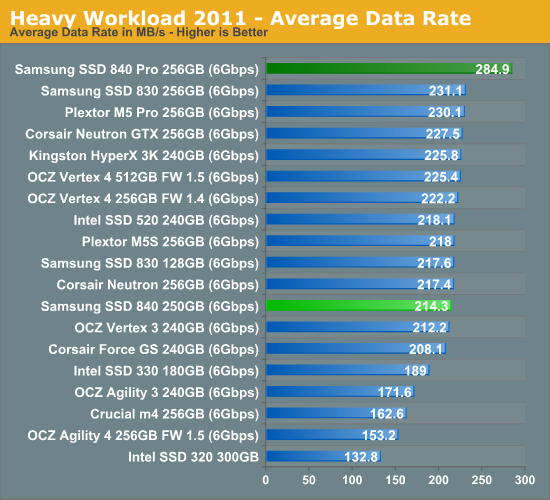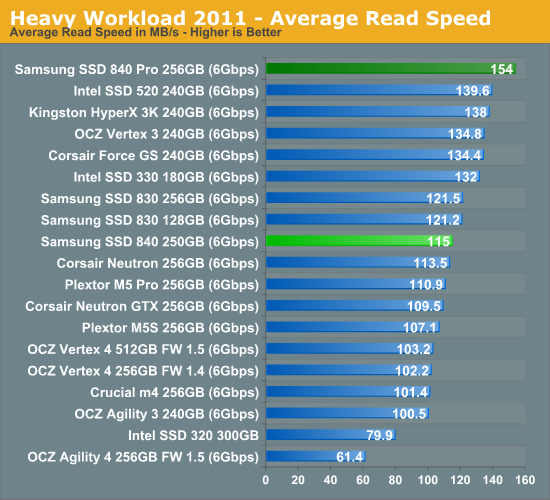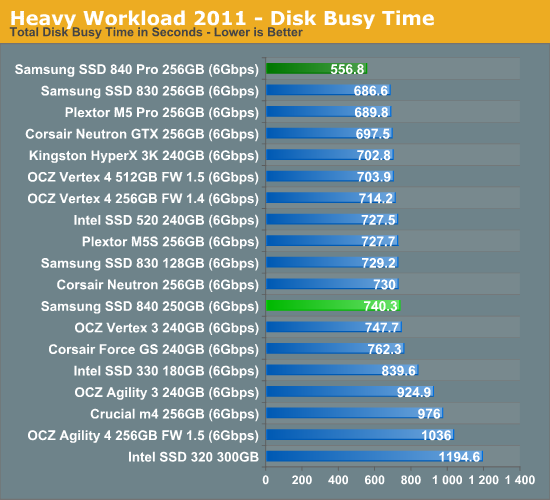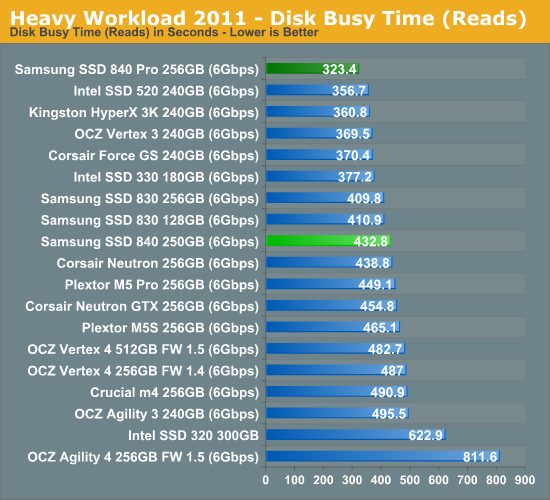Samsung SSD 840 (250GB) Review
by Kristian Vättö on October 8, 2012 12:14 PM EST- Posted in
- Storage
- SSDs
- Samsung
- TLC
- Samsung SSD 840
AnandTech Storage Bench 2011
Last year we introduced our AnandTech Storage Bench, a suite of benchmarks that took traces of real OS/application usage and played them back in a repeatable manner. Anand assembled the traces out of frustration with the majority of what we have today in terms of SSD benchmarks.
Although the AnandTech Storage Bench tests did a good job of characterizing SSD performance, they weren't stressful enough. All of the tests performed less than 10GB of reads/writes and typically involved only 4GB of writes specifically. That's not even enough exceed the spare area on most SSDs. Most canned SSD benchmarks don't even come close to writing a single gigabyte of data, but that doesn't mean that simply writing 4GB is acceptable.
Originally we kept the benchmarks short enough that they wouldn't be a burden to run (~30 minutes) but long enough that they were representative of what a power user might do with their system. Later, however, we created what we refer to as the Mother of All SSD Benchmarks (MOASB). Rather than only writing 4GB of data to the drive, this benchmark writes 106.32GB. This represents the load you'd put on a drive after nearly two weeks of constant usage. And it takes a long time to run.
1) The MOASB, officially called AnandTech Storage Bench 2011—Heavy Workload, mainly focuses on the times when your I/O activity is the highest. There is a lot of downloading and application installing that happens during the course of this test. Our thinking was that it's during application installs, file copies, downloading, and multitasking with all of this that you can really notice performance differences between drives.
2) We tried to cover as many bases as possible with the software incorporated into this test. There's a lot of photo editing in Photoshop, HTML editing in Dreamweaver, web browsing, game playing/level loading (Starcraft II and WoW are both a part of the test), as well as general use stuff (application installing, virus scanning). We included a large amount of email downloading, document creation, and editing as well. To top it all off we even use Visual Studio 2008 to build Chromium during the test.
The test has 2,168,893 read operations and 1,783,447 write operations. The IO breakdown is as follows:
| AnandTech Storage Bench 2011—Heavy Workload IO Breakdown | ||||
| IO Size | % of Total | |||
| 4KB | 28% | |||
| 16KB | 10% | |||
| 32KB | 10% | |||
| 64KB | 4% | |||
Only 42% of all operations are sequential; the rest ranges from pseudo to fully random (with most falling in the pseudo-random category). Average queue depth is 4.625 IOs, with 59% of operations taking place in an IO queue of 1.
Many of you have asked for a better way to really characterize performance. Simply looking at IOPS doesn't really say much. As a result we're going to be presenting Storage Bench 2011 data in a slightly different way. We'll have performance represented as Average MB/s, with higher numbers being better. At the same time we'll be reporting how long the SSD was busy while running this test. These disk busy graphs will show you exactly how much time was shaved off by using a faster drive vs. a slower one during the course of this test. Finally, we will also break out performance into reads, writes, and combined. The reason we do this is to help balance out the fact that this test is unusually write intensive, which can often hide the benefits of a drive with good read performance.
There's also a new light workload for 2011. This is a far more reasonable, typical every day use case benchmark. It has lots of web browsing, photo editing (but with a greater focus on photo consumption), video playback, as well as some application installs and gaming. This test isn't nearly as write intensive as the MOASB but it's still multiple times more write intensive than what we were running last year.
We don't believe that these two benchmarks alone are enough to characterize the performance of a drive, but hopefully along with the rest of our tests they will help provide a better idea. The testbed for Storage Bench 2011 has changed as well. We're now using a Sandy Bridge platform with full 6Gbps support for these tests.
AnandTech Storage Bench 2011—Heavy Workload
We'll start out by looking at average data rate throughout our new heavy workload test:

The 840 is quite average in our Heavy suite and performs similarly to most SandForce drives. The 840 Pro is a lot faster under heavy workloads, so it should be obvious by now why Samsung is offering two SSDs instead of one like they used to.


The next three charts just represent the same data, but in a different manner. Instead of looking at average data rate, we're looking at how long the disk was busy for during this entire test. Note that disk busy time excludes any and all idles, this is just how long the SSD was busy doing something:













86 Comments
View All Comments
Kristian Vättö - Tuesday, October 9, 2012 - link
Samsung will be releasing Magician 4.0 later this year and we are definitely going to do an article about it. I tried to get a beta version of it but Samsung wasn't willing to send us one, yet. Magician 3.2.2 that comes with the 840 is the same that's available for the 830, so I didn't find it that important to cover.But you are right, we need to cover the software side more as well because it will also drive manufacturers to make their own SSD tools.
P.S. Try installing Ubuntu to a USB stick (just use UNetBootin) and then use hdparm commands (see below) to secure erase the SSD.
sudo hdparm --user-master u --security-set-pass password /dev/sdX
sudo hdparm --user-master u --security-erase password /dev/sdX
"password" is whatever you choose as the password and "X" is the drive (you can see which it is in Disk Utility)
Impulses - Monday, October 8, 2012 - link
At one point in the article you mention 830 users would at least wanna upgrade to the 840 Pro if they aren't gonna wait for next gen drives... I kinda thought the Pro qualified as next gen, with the vanilla 840 being more of a side grade from current gen drives. So what would you consider or expect from a next gen drive?KAlmquist - Tuesday, October 9, 2012 - link
One thing I've been wondering is what voltage the controller uses. I can't identify every component on the board, but I don't see anything that looks like a voltage regulator. It seems kind of crazy to run a chip with three processor cores at 5 volts, but I guess it's possible.Death666Angel - Tuesday, October 9, 2012 - link
Loved the review. I'm really looking forward to more data on the DSP usefulness inside SSDs, could be a huge advantage (though I don't worry about going through my P/E cycles at home).With SSDs, we are at a point similar to GPUs and CPUs where I don't understand upgrading from generation to generation. Unless you have a very specific usage case and can make great use of the better speed (video/picture editing or something equally I/O intensive), I don't think a 840 Pro will feel that much faster than a 830.
I'm still rocking a first gen Agility 60GB in my (ULV) notebook and a Vertex2 120GB in my desktop and they feel plenty fast, especially those times when I'm at a friends PC with only mechanical storage.
I might upgrade to a 830 or 840 (non Pro) when the prices have dropped for the 830 or stabilized for the 840 (I don't like paying for launch pricing). :D
And I finally got my brother to go to SSD storage, too! He'll either get a 512GB 830 or 2x256. Does anyone know why 256GB usually has the best price/GB instead of the 512GB drives? Considering the cost for casing, PCB, controller etc. stays the same, I would expect the 512GB to have better pricing/GB. Do they need to go with more dense packages which are more expensive?
name99 - Tuesday, October 9, 2012 - link
I agree completely.I've said before that the current emphasis on performance over everything else is as stupid as Intel's Pentium4 philosophy. Devices have to become more balanced if they want to sell better.
In particular the current atrocious write power draws for these devices mean that they will not sell in the external drive market --- they can't be fully powered by USB2 and
- no-one wants a drive that needs two USB connections because it's clumsy and it uses up limited USB slots
- saying it can be fully powered by USB3 is not good enough because, for the near-term future, people want to share drives between USB2 and USB3 computers.
Of course MOST, but not all, the external drive market is about capacity, not speed. However each time SSD capacity doubles, a larger portion of the external drive market makes sense; AND power is not only an issue for the external market. The higher you set your peak power draw, the less your flash appeals to Ultrabook manufacturers.
Just remember Pentium 4 and its power draw, and compare to Intel trying to get Haskell to run at <10W nowadays. Balance matters, and current flash manufacturers seem to be far too unbalanced compared to the requirements of most users.
(It would be fascinating, for example, if we learn that the flash in the next round of iOS devices, or even MacBooks, was designed in-house by Apple because they were not satisfied with the power vs performance choices that were being made by the major flash manufacturers. Remember --- Apple bought Anobit...)
moadip - Tuesday, October 9, 2012 - link
does the 830/840 family support AES encryption? Want to buy one of those but there is no official word on any support for this. Is anyone of you guys/girls using them in that way?Kristian Vättö - Tuesday, October 9, 2012 - link
840 and 840 Pro both support 256-bit AES encryptionmoadip - Tuesday, October 9, 2012 - link
what about the 830?Kristian Vättö - Tuesday, October 9, 2012 - link
I'm not 100% sure but as far as I know, only the OEM/enterprise version (i.e. PM830) supports encryption, the consumer 830 doesn't.MrSpadge - Tuesday, October 9, 2012 - link
What an amazingly well balanced drive! Currently it's more expensive than the 830 at similar capacities, but as soon as 21 nm yield ramps up (and prices are adjusted) this will probably be one of the best or maybe the best consumer SSD on the market.